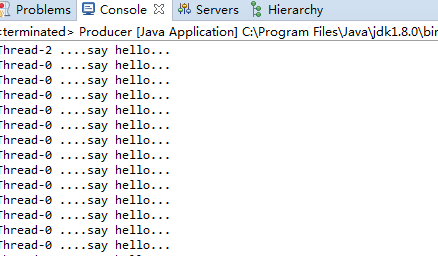简述
生成者消费者模式,在并发编程模式里面很常见。无边界是指消息队列,没有设置,具体大小。
下面是常见的两种模式通用类
MyTask : 定义了任务接口
package com.ricisung.Model.chapter1;
public abstract class MyTask {
abstract void doSomething();
}
SayHelloTask: 它是MyTask 的实现类; 主要打印一句hello
package com.ricisung.Model.chapter1;
public class SayHelloTask extends MyTask {
@Override
void doSomething() {
System.out.println(Thread.currentThread().getName() +" ...." +"say hello...");
}
}
- 第一种消费者模式
每个线程持有一个任务队列。用消费代理分发给不同的线程处理,详细如下:
Customer
package com.ricisung.Model.chapter1;
import java.util.concurrent.BlockingQueue;
import java.util.concurrent.LinkedBlockingQueue;
import org.apache.log4j.Logger;
public class Customer extends Thread {
private static Logger logger = Logger.getLogger(Customer.class);
private BlockingQueue<MyTask> queue = new LinkedBlockingQueue<MyTask>();
public void putTask(MyTask task) throws InterruptedException {
queue.add(task);
}
@Override
public void run() {
while (true) {
try {
MyTask task = queue.take();
task.doSomething();
} catch (Throwable e) {
logger.error("",e);
}
}
}
}
消息代理: 消费者代理,随机选取一个消费者,进行消费
CustomerProxy :
package com.ricisung.Model.chapter1;
import java.util.Random;
import org.apache.log4j.Logger;
public class CustomerProxy {
private static Logger logger = Logger.getLogger(CustomerProxy.class);
private static CustomerProxy instance = null;
private Customer[] customers = null;
private final int MAX_SIZE = 4;
private CustomerProxy() {
customers = new Customer[MAX_SIZE];
for (int i = 0; i < MAX_SIZE; i++) {
customers[i] = new Customer();
customers[i].setDaemon(true);
customers[i].start();
}
}
public static synchronized CustomerProxy instance() throws InterruptedException {
if (null == instance) {
instance = new CustomerProxy();
}
return instance;
}
public void doWork(MyTask task) {
int index = new Random().nextInt(MAX_SIZE);
try {
customers[index].putTask(task);
} catch (Throwable e) {
logger.error("",e);
}
}
}
- 第二种模式:只有消费代理有一个任务队列,所有的线程都从消费代理的任务队列中获取任务。
CustomerProxy1
package com.ricisung.Model.chapter1;
import java.util.concurrent.BlockingQueue;
import java.util.concurrent.LinkedBlockingQueue;
import org.apache.log4j.Logger;
public class CustomerProxy1 {
private static Logger logger = Logger.getLogger(CustomerProxy1.class);
private static CustomerProxy1 instance = null;
private Customer1[] customers = null;
private final int MAX_SIZE = 4;
private BlockingQueue<MyTask> queue = new LinkedBlockingQueue<MyTask>();
private CustomerProxy1() {
customers = new Customer1[MAX_SIZE];
for (int i = 0; i < MAX_SIZE; i ++) {
customers[i] = new Customer1();
customers[i].setDaemon(true);
customers[i].start();
}
}
public static synchronized CustomerProxy1 instance() {
if (null == instance) {
instance = new CustomerProxy1();
}
return instance;
}
public void doWork(MyTask task) {
try {
queue.add(task);
} catch (Throwable e) {
logger.error("",e);
}
}
class Customer1 extends Thread {
@Override
public void run() {
while(true) {
try {
MyTask task = queue.take();
task.doSomething();
} catch (Throwable e) {
logger.error("",e);
}
}
}
}
}
Producer 生成者
package com.ricisung.Model.chapter1;
public class Producer {
public static void main(String args[]) throws InterruptedException {
//oneModel();
twoModel();
}
public static void oneModel() throws InterruptedException {
for (int i = 0; i < 100; i ++) {
CustomerProxy.instance().doWork(new SayHelloTask());
}
Thread.sleep(1000 * 5);
}
public static void twoModel() throws InterruptedException {
for (int i = 0; i < 100; i ++) {
CustomerProxy1.instance().doWork(new SayHelloTask());
}
Thread.sleep(1000 * 5);
}
}
测试结果:
两种模式的比较
两种默认都可以有效的完成任务。
第一种,每个线程都具有一个自己的任务队列,这种模式相比第二种模式,CPU减少了在不同线程阻塞,减少了线程排队同步问题。
第二种,因为多个线程同时共享了一个队列,所以这种模式更充分的利用了线程; 第一种模式中一个线程完成任务了,就会立即阻塞,不会帮助其他线程共同完成任务;
如果多种任务同时存在,并且不同任务之间需要按相互先后顺序,使用第一种模式就能很好的解决此类问题:将有依赖关系的任务放到同一个线程里进行处理。
7.源码下载地址
http://download.csdn.net/detail/jia281460530/9539500






















 2423
2423











 被折叠的 条评论
为什么被折叠?
被折叠的 条评论
为什么被折叠?








